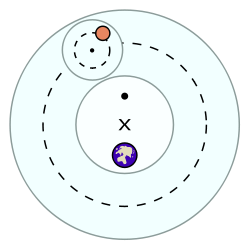
Equant
Encyclopedia

The equant point, indicated in the diagram by the large • , is placed so that it is directly opposite the Earth from the center of the deferent
Deferent and epicycle
In the Ptolemaic system of astronomy, the epicycle was a geometric model used to explain the variations in speed and direction of the apparent motion of the Moon, Sun, and planets...
, indicated by the ×. A planet or the center of an epicycle (a smaller circle carrying the planet) was conceived to move with a uniform speed with respect to the equant. In other words, to a hypothetical observer placed at the equant point, the center of the epicycle would appear to move at a steady speed. However, the planet/center of epicycle will not move uniformly on its deferent.
The angle α between the axis on which the equant and the Earth lie is a function of time t:
where Ω is the constant angular speed seen from the equant which is situated at a distance E when the radius of the deferent is R.
This concept solved the problem of accounting for the anomalistic motion of the planets but was believed by some to compromise the goals of the ancient astronomer, namely uniform circular motion. Noted critics of the equant include the Persian astronomer Nasir al-Din Tusi who developed the Tusi-couple
Tusi-couple
The Tusi-couple is a mathematical device in which a small circle rotates inside a larger circle twice the diameter of the smaller circle. Rotations of the circles cause a point on the circumference of the smaller circle to oscillate back and forth in linear motion along a diameter of the larger...
as an alternative explanation , and Nicolaus Copernicus
Nicolaus Copernicus
Nicolaus Copernicus was a Renaissance astronomer and the first person to formulate a comprehensive heliocentric cosmology which displaced the Earth from the center of the universe....
. Dislike of the equant was a major motivation for Copernicus to construct his heliocentric system.
External links
- Ptolemaic System – at Rice University's Galileo Project
- Java simulation of the Ptolemaic System – at Paul Stoddard's Animated Virtual Planetarium, Northern Illinois University
See also
- EquidimensionalEquidimensionalEquidimensional is an adjective applied to objects that have nearly the same size or spread in multiple directions. As a mathematical concept, it may be applied to objects that extend across any number of dimensions...
: This is a synonym for equant when it is used as an adjective.


